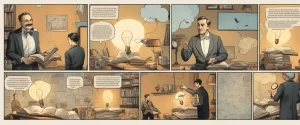——The Boy Who Was Raised as a Dog by Bruce D. Perry & Many Lives Many Masters by Brian L. Weiss

In the dynamic realm of literature, authors often embark on journeys of exploration into the intricacies and mysteries of the human mind. Two such fascinating works, “The Boy Who Was Raised as a Dog” by Bruce D. Perry and “Many Lives Many Masters” by Brian L. Weiss, delve into the depths of human consciousness, offering unique perspectives on trauma and past-life regression therapy, respectively. These captivating books invite readers to question the limits of human resilience and the uncharted territories of the subconscious mind. Through the masterful storytelling and the profound insights shared by the authors, both works offer contrasting yet complementary lenses into the complex nature of human experiences and our innate capacity for healing and transformation. In this comparative study, we will navigate the domains of psychology and spirituality, journeying alongside troubled individuals through their transformative paths, as we unravel the similarities and disparities between these two remarkable literary works. By delving into the core themes of trauma, healing, and the human psyche, this study aims to provide a nuanced understanding of the profound journeys undertaken by the protagonists, shedding light on the beauty and complexity of the human condition.
Brief Summary of Two Books
The Boy Who Was Raised as a Dog by Bruce D. Perry
“The Boy Who Was Raised as a Dog” by Bruce D. Perry is a captivating and enlightening book that explores the impact of early trauma on the developing brain. Drawing from his experiences as a child psychiatrist, Perry shares compelling stories of children he has encountered in his practice, each one presenting unique challenges and insights.
Using a combination of scientific research and real-life cases, Perry delves into the field of developmental neuroscience to explain how early trauma, such as abuse, neglect, or witnessing violence, can shape the brain’s architecture and impact a child’s emotional and psychological well-being. Through these stories, he highlights the importance of understanding and addressing trauma at an early age to promote healing and resilience.
Perry emphasizes that children who have experienced severe trauma often display a range of psychological and behavioral issues, from emotional dysregulation to difficulties forming healthy relationships. However, he also highlights the incredible potential for healing and growth when appropriate interventions are implemented.
“The Boy Who Was Raised as a Dog” serves as a poignant reminder of the power of love and connection in healing trauma. Through the narrative, Perry offers valuable insights into the complex workings of the human brain as it relates to trauma and provides practical strategies for professionals, parents, and caregivers to promote healing in traumatized children.
Overall, this book offers an insightful exploration of the long-lasting impact of early trauma on the developing brain, shedding light on the need for trauma-informed approaches in addressing the needs of children who have experienced significant adversity. It is a must-read for anyone interested in understanding the effects of trauma on children and providing them with the support and care they deserve.
Many Lives Many Masters by Brian L. Weiss
“Many Lives, Many Masters” by Brian L. Weiss is a thought-provoking and deeply personal account of a psychiatrist’s exploration into past-life therapy. Dr. Weiss, a traditional psychotherapist, shares the true story of his patient, Catherine, and her fascinating journey of uncovering her past lives during hypnosis. As the therapeutic sessions progress, Catherine’s subconscious memories reveal not only her own past lives but also profound spiritual wisdom imparted by beings known as Masters. These Masters teach her valuable lessons about love, healing, and the purpose of human existence. Driven by curiosity and a desire to help his patient overcome her fears and anxieties, Dr. Weiss gradually becomes a believer in reincarnation and the eternal nature of the soul. This transformation challenges his scientific beliefs and forever changes the way he approaches therapy. Through Catherine’s experiences, the book offers a fascinating perspective on spirituality and the potential for personal growth through past-life regression therapy. It encourages readers to consider the interconnectedness of all beings and the infinite possibilities that exist beyond the limitations of a single lifetime.
Comparison between Two Books

Similarities in Psychological Healing
Both “The Boy Who Was Raised as a Dog” by Bruce D. Perry and “Many Lives Many Masters” by Brian L. Weiss explore the theme of psychological healing in their respective narratives.
1. Trauma and its Impact: Both books emphasize the significant impact of early-life trauma on an individual’s psychological well-being. Perry’s book focuses on the effects of neglect, abuse, and other adverse childhood experiences, while Weiss’s book delves into past-life traumas and how they can manifest in the present. Both authors highlight the need to address and heal these traumas for true psychological healing to occur.
2. The Power of Therapy: Both books highlight the importance of therapy and therapeutic interventions in facilitating psychological healing. Perry, as a renowned child psychiatrist, shares his experiences in using trauma-informed therapy to help children recover from severe psychological traumas. Similarly, Weiss narrates his use of past-life therapy, which involves accessing past life memories through hypnosis, to help his patients overcome present-day issues rooted in unresolved traumas.
3. Neuroplasticity and Healing: Both books touch upon the concept of neuroplasticity, the brain’s ability to reorganize itself and form new neural connections. Perry discusses how early traumatic experiences can shape the developing brain negatively, but also highlights the brain’s capacity for healing and rewiring through therapeutic interventions. Similarly, Weiss’s book implies that healing past-life traumas can positively affect an individual’s present life by altering their thoughts, behaviors, and emotional patterns.
4. Compassionate Approach: Both authors stress the importance of a compassionate and empathetic approach when working with individuals who have experienced psychological trauma. Perry emphasizes the significance of building trust and providing a nurturing environment for healing, particularly for children. Weiss recounts his gentle and non-judgmental approach to helping his patients recall and resolve past-life traumas. Both books underscore the transformative power of empathy and understanding in the healing process.
5. Integration and Wholeness: Ultimately, both books emphasize the goal of achieving integration and wholeness as a result of the psychological healing process. Perry shares stories of children who, with proper therapeutic interventions, are able to integrate their fragmented experiences and develop resilience. Similarly, Weiss describes patients who, through resolving past-life traumas, experience a sense of completion and attain a more fulfilling and balanced life in the present.
In summary, “The Boy Who Was Raised as a Dog” and “Many Lives Many Masters” share several key similarities in their exploration of psychological healing. Both books acknowledge the lifelong impact of trauma, advocate the power of therapy, and highlight the importance of empathy and a compassionate approach. Neuroplasticity and the pursuit of integration are also common themes found in both narratives.
Divergences in Psychological Healing
The Boy Who Was Raised as a Dog by Bruce D. Perry and Many Lives Many Masters by Brian L. Weiss are both highly acclaimed books that delve into different aspects of psychological healing, but they approach the topic from distinct perspectives and with different focuses.
In The Boy Who Was Raised as a Dog, Bruce D. Perry, a renowned child psychiatrist, shares his experiences working with traumatized children. He examines the impact of early childhood trauma on brain development and explains how these adverse experiences can shape a child’s psychological and emotional state. Through his case studies, Perry emphasizes the importance of understanding and addressing trauma to facilitate healing in young individuals. He explores the concept of neurosequential development, which provides a framework for understanding the impacts of trauma on different parts of the brain as well as the critical role of relationships in healing.
On the other hand, Many Lives Many Masters, written by Brian L. Weiss, focuses on the exploration of past life regression therapy as a means of psychological healing. The book delves into Weiss’ experiences with a patient named Catherine, who, through hypnosis sessions, recalls her past lives and explores the concept of reincarnation. Weiss presents evidence supporting the idea of multiple lives and suggests that past-life traumas can manifest as psychological issues in the present life. By addressing these past-life traumas through regression therapy, he argues for the possibility of resolving psychological issues and achieving healing.
The main divergence between these two books lies in their approaches to psychological healing. Perry’s work in The Boy Who Was Raised as a Dog is firmly rooted in neuroscience, attachment theory, and trauma-informed care. He emphasizes the importance of understanding the effects of early trauma on brain development and proposes trauma-focused interventions and therapies for healing. Perry’s focus is on the here and now, emphasizing the importance of relationships and interventions that address specific traumas in a person’s life.
In contrast, Weiss explores the realm of spirituality and past-life regression therapy in Many Lives Many Masters. He proposes that healing can be facilitated by addressing past-life traumas through hypnosis, ultimately leading to the resolution of current psychological issues. Weiss’ approach is deeply spiritual and relies on the belief in reincarnation and the existence of past lives.
While both books aim to shed light on psychological healing, it is essential to note their different perspectives. The Boy Who Was Raised as a Dog focuses on evidence-based neuroscience, attachment theory, and trauma-informed care, whereas Many Lives Many Masters delves into spirituality, past-life regression therapy, and the exploration of alternative healing methods.

Conclusion
Both “The Boy Who Was Raised as a Dog” by Bruce D. Perry and “Many Lives Many Masters” by Brian L. Weiss are highly valued books in their respective fields. However, the worthiness of reading these books depends on individual preferences and interests.
“The Boy Who Was Raised as a Dog” explores the fascinating world of child trauma and its impact on brain development. Dr. Bruce D. Perry shares captivating stories from his experiences as a child psychiatrist, shedding light on the resiliency of the human brain and the healing power of compassionate relationships. This book offers valuable insights into the effects of trauma on children and the importance of trauma-informed care.
On the other hand, “Many Lives Many Masters” dives into the intriguing subject of past-life regression therapy. Dr. Brian L. Weiss recounts his experience with a patient who underwent hypnosis and recalled past lives, leading to profound personal transformations. This book delves into spiritual concepts and provides a unique perspective on life, death, and the existence of past lives.
To determine which book is more worthy of reading, you should consider your personal interests. If you are passionate about psychology, child development, and understanding how trauma shapes individuals’ lives, “The Boy Who Was Raised as a Dog” might be a better fit for you. Conversely, if you have an interest in spirituality, past lives, and exploring the metaphysical aspects of existence, “Many Lives Many Masters” may be more appealing.
Both books offer valuable insights and have received positive reviews, so ultimately, it is up to you to decide which topic resonates more strongly with your interests and which book you believe will provide the most meaningful experience.


